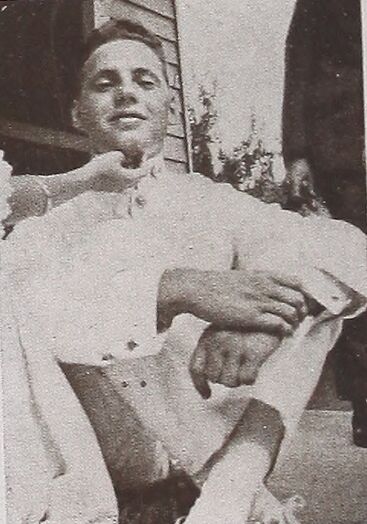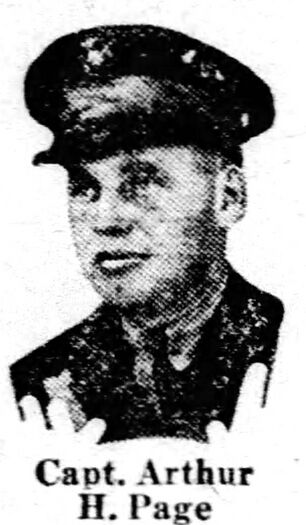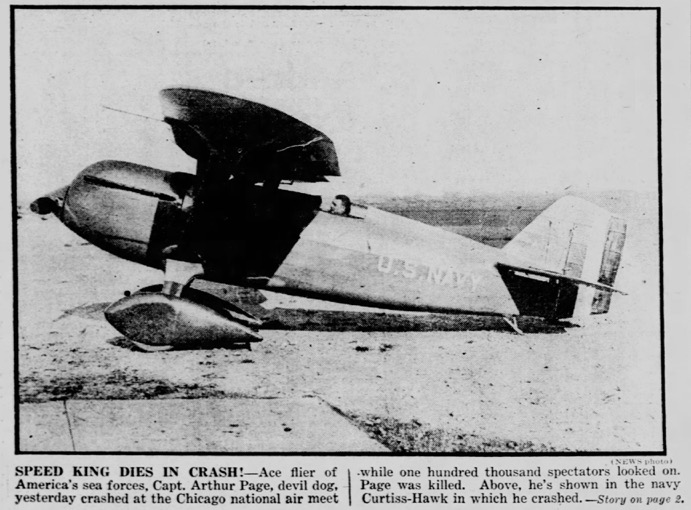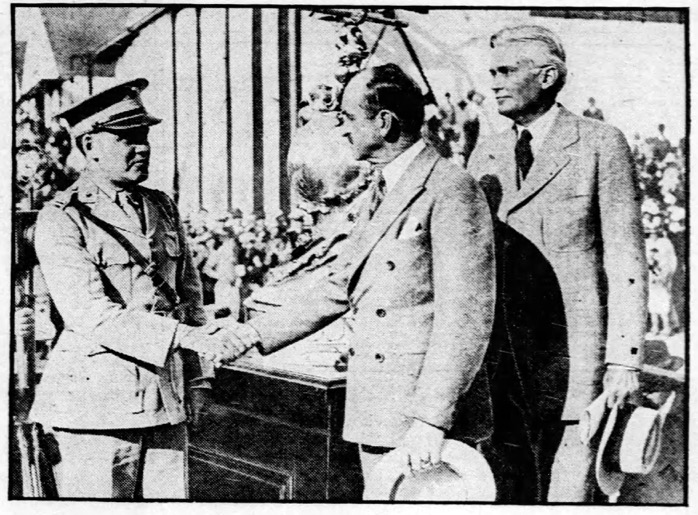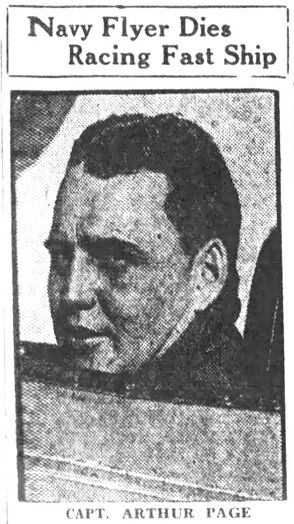ARTHUR H. PAGE, JR., CAPT, USMC
Arthur Page, Jr. '18
Lucky Bag
From the 1918 Lucky Bag:
ARTHUR HALLET PAGE, Jr.
New York City, New York
"Arthur" "Phyllis"
ARTHUR—a remarkable character—embodying the unexampled combination of sane good judgment, vocal skill, professional dancing ability, individual taste (votes dry), as well as being a real New Yorker with good looks, parting his hair in the middle, intimately acquainted with a 4.0 queen having considerable talent. Wonderful? Yes!
As for daring, or perhaps foolishness, he has smoked incessantly, with two paps hanging over his head, since plebe summer; but with an inborn cleverness for sensing the O. C. coupled with lots of good luck and fast foot work, he has been able to sign the Saturday evening list on the Assistant's table. His most interesting encounter was that with Hobey Baker under second class stairs.
Every man has his forte, and Phyllis's is music. After dinner each evening, A. Caruso Page and several of his cohorts proceed to terrify some quiet corner of Smoke Hall with a very superior brand of harmony. Many a Sunday has been helped along by his entertainments in Chapel.
During second class leave Arthur witnessed a Broadway performance "Three Days in a Trench" and henceforth his choice was made—the Marine Corps. Tales of horrible experiences among the wild savages have failed to soften his decisions, and he maintains positively that a Bolo Rush is fruit compared with a Dago recitation.
For a man that came back, you deserve much credit, and we will miss your cheery song and pleasing manner. Also congratulations, you'll make a refined hubby.
"Let thy mercy be upon us!"
Choir (4, 3, 2, 1); Buzzard; Expert Rifleman; Glee Club (4, 3, 2, 1) Leader of Glee Club (1); Hop Committee (1)
The Class of 1918 was graduated on June 28, 1917 due to World War I.
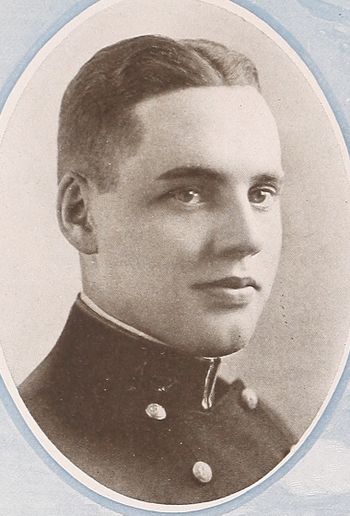
ARTHUR HALLET PAGE, Jr.
New York City, New York
"Arthur" "Phyllis"
ARTHUR—a remarkable character—embodying the unexampled combination of sane good judgment, vocal skill, professional dancing ability, individual taste (votes dry), as well as being a real New Yorker with good looks, parting his hair in the middle, intimately acquainted with a 4.0 queen having considerable talent. Wonderful? Yes!
As for daring, or perhaps foolishness, he has smoked incessantly, with two paps hanging over his head, since plebe summer; but with an inborn cleverness for sensing the O. C. coupled with lots of good luck and fast foot work, he has been able to sign the Saturday evening list on the Assistant's table. His most interesting encounter was that with Hobey Baker under second class stairs.
Every man has his forte, and Phyllis's is music. After dinner each evening, A. Caruso Page and several of his cohorts proceed to terrify some quiet corner of Smoke Hall with a very superior brand of harmony. Many a Sunday has been helped along by his entertainments in Chapel.
During second class leave Arthur witnessed a Broadway performance "Three Days in a Trench" and henceforth his choice was made—the Marine Corps. Tales of horrible experiences among the wild savages have failed to soften his decisions, and he maintains positively that a Bolo Rush is fruit compared with a Dago recitation.
For a man that came back, you deserve much credit, and we will miss your cheery song and pleasing manner. Also congratulations, you'll make a refined hubby.
"Let thy mercy be upon us!"
Choir (4, 3, 2, 1); Buzzard; Expert Rifleman; Glee Club (4, 3, 2, 1) Leader of Glee Club (1); Hop Committee (1)
The Class of 1918 was graduated on June 28, 1917 due to World War I.
Loss
Arthur was lost on September 1, 1930 when the aircraft he was piloting crashed during the Thompson Trophy Race at the National Air Races in Chicago, Illinois.
Other Information
From researcher Kathy Franz:
Arthur was born in Saint Paul, Minnesota. When he was 8 years old, he and his mother sailed from Kingston, Jamaica, to Ellis Island on the S. S. Sarnia in August, 1904.
He married Florence I. Shaw on August 25, 1917, in Philadelphia. She graduated from the Elmira College of Music.
In March, 1918, Arthur and two other planes flew over the Boston-Philadelphia baseball game in Miami, Florida. The other two planes dropped four balls into the field which were later auctioned off at $30 apiece.
In May, 1924, Arthur won the secnd heat of the 100-mile race at the southern air meet at Birmingham, Alabama. In the first heat of 50 miles, Arthur’s plane was in flames on the last quarter-mile lap.
He crossed the line in front and then zoomed 1,500 feet and “side-slipped” the fire out. A hole had burned in the body from a leaking gas line and a hot engine.
In September, 1928, Arthur, his wife and son sailed from Taku Bar, China, to San Diego.
In July, 1929, he won the cross-country race of the Williamsport air show which brought four planes to Elmira, New York, and return.
In June, 1930, Arthur set a new record of 164.08 miles an hour over the 100-mile course at the eleventh annual Curtiss marine trophy race at Washington, D. C.
In 1895, Arthur’s family lived in the David Stuart House at 312 Summit Avenue in St. Paul with Arthur’s grandparents, banker and Mayor Robert and his wife Mary Smith. In October, 1887, the Smiths hosted a luncheon for president and Mrs. Grover Cleveland. In 1895, a coachman, cook, servant, nurse and laundress were employed at the house.
Arthur’s father was a broker who began business in May, 1899, in the firm of Page & Co. It was dissolved in November, 1900. A member of the NYSE up to February, 1901, he sold his seat and became a member of the Consolidated Stock and Petroleum exchange. He then formed Arthur H. Page & Co. in September 1902, but it was dissolved a year later. His bankruptcy case was closed in April, 1909. Arthur’s parents were divorced by 1910. His mother was Clara Mina (Smith.) His older siblings Robert and Phyllis were born in New Jersey.
From Find A Grave:
Second Lieutenant A. H. Page, USMC, was designated Naval Aviator #536 on 14 March 1918. Later assigned #775 by the Marine Corps. Graduated U.S. Naval Academy in 1917, Class of 1918 (one year early due to the World War).
Awarded the DFC (posthumous) for completing the longest recorded blind flight, from Omaha, Neb. to Anacostia, WDC on 21 July 1930.
Died as the result of his sacrificial crash during the Thompson Trophy Race at the National Air Races, in Chicago.
Page Field at MCB Parris Is., SC was named in his honor on 19 Sept. 1938.
Was the son of Arthur Senior and the former Miss Mina Smith. Had married Miss Florence I. Shaw in 1917.
From researcher Kathy Franz:
The Standard Union newspaper reported that “his green plane slowed down, turned on its side and “cut” the home pylon. . . . It seemed for a fraction of a second he lost control. He righted the ship, however, and sailed across the field, turned to his left, made an heroic attempt to bring his ship down with the wind to avoid striking the crowds, could not quite complete the turn, and crashed.” They did take a blood sample to see if he was overcome by carbon monoxide. However, another aviator said he controlled the ship not to crash into the crowd.
His wife remarried another Marine (who was later killed in action at Guadalcanal); she then remarried again to a third Marine, Brigadier General Charles Sanderson. Arthur was also survived by a son, Arthur H. Page, III.
Arthur was earlier commanding officer of the "4th Air Squadron" in 1921.
Photographs
Distinguished Flying Cross
From Hall of Valor:
The President of the United States of America takes pleasure in presenting the Distinguished Flying Cross to Captain Arthur H. Page, Jr. (MCSN: 0-730), United States Marine Corps, for extraordinary achievement while participating in aerial flight on 21 July 1930. Captain Page successfully completed the longest recorded blind flight as pilot in an 2U-1 airplane from Omaha, Nebraska, to Anacostia, D.C., a distance of approximately one thousand miles, flying blind the entire distance, at time through rain storms and clouds and negotiating the entire flight in one day. Captain Page's pioneering, scientific study and successful accomplishments in the art of blind flying have contributed much towards the advancement of aeronautics.
General Orders: CITATION:
Service: Marine Corps
Rank: Captain
His widow is pictured with the Commandant of the Marine Corps and the Assistant Secretary of the Navy in 1930.
Other
From A modeling kit description:
The Curtiss “Page Racer” is one of the more mysterious speed machines of the Golden Age of air racing, and Army / Navy rivalry in the Pulitzer and Thompson races. Built under false fighter designation, from borrowed and “appropriated” components, the XF6C-6 began life as a fairly common Curtiss Hawk and went from an ungainly biplane to a sleek parasol monoplane in relative secrecy. In every sense this plane was a true Hot Rod. Unlike the service Hawk, the racer had a supercharged Curtiss Conqueror engine, and used nearly flush mounted corrugated brass surface radiators for cooling., and streamlining was taken to extremes with fillets at all strut junctions and no zippered servicing patches in the covering of the fuselage. A beautifully shaped cowl and spinner covered the V-12 engine, with hooded exhausts barely protruding into the airstream. The pilot's head was faired into the fuselage fore and aft in an effort to reduce drag.
In the 1930 Thompson race, the XF6C-6 tragically crashed on it’s 17th lap when Captain Page was overcome by carbon monoxide fumes trapped in the fuselage. When the facts concerning the construction of the racer became known, there was quite a scandal and a number of Courts-Martial were held and careers ruined. One is left wondering how differently things might have played out had the Page Racer won the race as it was obviously capable of and had Captain Page survived to bring glory to the Navy and Marines.
The "Register of Commissioned and Warrant Officers of the United States Navy and Marine Corps" was published annually from 1815 through at least the 1970s; it provided rank, command or station, and occasionally billet until the beginning of World War II when command/station was no longer included. Scanned copies were reviewed and data entered from the mid-1840s through 1922, when more-frequent Navy Directories were available.
The Navy Directory was a publication that provided information on the command, billet, and rank of every active and retired naval officer. Single editions have been found online from January 1915 and March 1918, and then from three to six editions per year from 1923 through 1940; the final edition is from April 1941.
The entries in both series of documents are sometimes cryptic and confusing. They are often inconsistent, even within an edition, with the name of commands; this is especially true for aviation squadrons in the 1920s and early 1930s.
Alumni listed at the same command may or may not have had significant interactions; they could have shared a stateroom or workspace, stood many hours of watch together, or, especially at the larger commands, they might not have known each other at all. The information provides the opportunity to draw connections that are otherwise invisible, though, and gives a fuller view of the professional experiences of these alumni in Memorial Hall.
March 1918
January 1919
January 1920
January 1921
July 1923
September 1923
November 1923
January 1924
March 1924
May 1924
July 1924
September 1924
November 1924
January 1925
March 1925
May 1925
July 1925
October 1925
January 1926
October 1926
January 1927
April 1927
October 1927
January 1928
April 1928
July 1928
January 1929
April 1929
July 1929
October 1929
January 1930
April 1930

The "category" links below lead to lists of related Honorees; use them to explore further the service and sacrifice of alumni in Memorial Hall.
